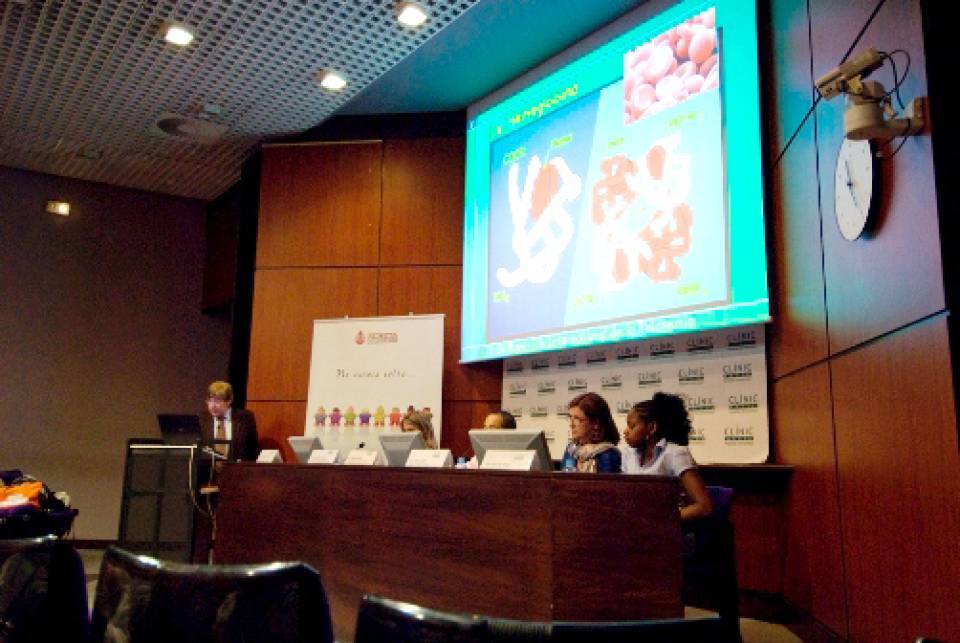In Europe, thalassemia major and sickle-cell anemia are the most common monogenic hereditary diseases and have a high mortality rate, particularly in children. In fact, in 2006, the World Health Organization recommended applying epidemiological monitoring methods and prophylaxis by means of prevention programs based on detecting carriers, genetic counselling and prenatal diagnosis neonatal screening in the case of sickle-cell anemia; these measures should be taken in states with a higher prevalence of this disease. The objective was to create a European network of reference centers capable of implementing these programs. In Spain, until recently, sickle-cell anemia was practically unknown, but today, it constitutes a considerable public health problem; however, only Madrid and Extremadura have implemented a neonatal screening program to deal with the disease. At Hospital Clínic, Barcelona, experts and patients have been demanding early diagnosis of hereditary anemias via neonatal screening programs, in order to tackle the progression of the disease and reduce its mortality.
In a press conference today, two days before the celebration of International Thalassemia Day, the Catalan hospital presented a report on the current state of this group of diseases, in the presence of the Spanish Association for the Fight Against Hemoglobinopathies and Thalassemias (ALHETA) and a patient diagnosed with sickle-cell anemia. The event was attended by the chairman of ALHETA, Antonio Cesar, who highlighted the needs and demands of patients with thalassemia major; Dr. Vives Corrons, head of the blood disease unit and coordinator of the ENERCA network, spoke about hemoglobinopathies in Spain; Dr. Anna Cabor, a pediatrician at Hospital de Mataró, discussed the impact of early diagnosis on the complications of sickle-cell anemia; and Maria del Mar Mañú, a biologist at the blood disease unit of Hospital Clínic, Barcelona, presented the programs for the prevention of major hemoglobin syndromes: thalassemia major and sickle-cell anemia.
On the occasion of International Thalassemia Day, to be held on 8 May, different educational activities will be carried out in Spain regarding the disease. Cities like Barcelona, Madrid, Las Palmas and Badajoz are taking part in the initiative with the installation of information desks and blood-extraction points. Combatting these diseases throws up challenges that cannot be contemplated without the commitment of society as a whole: patients, family members, professionals, the media, and even politicians. From Barcelona, Hospital Clínic is demanding greater visibility for hereditary anemias, specifically sickle-cell anemia - an emerging disease about which doctors are still not sufficiently well informed to perform early diagnosis.
The high incidence of sickle-cell anemia in Spain is due to the growing African immigrant population, in which cultural, social and religious barriers make it difficult to apply a control program involving prenatal diagnosis. Nevertheless, the development of a neonatal screening program would not involve these types of barriers and would allow early diagnosis of the disease and the implementation of therapeutic measures (antibiotics and vaccination). Thus, a neonatal screening program could, by providing information on prevalence, help to control the disease. If proper treatment is not received, the children can die before the age of 8 years. When properly treated, however, they have good quality of life and can study, work and form a family. Furthermore, a neonatal screening program would provide improved long-term care at a lower cost, due to the reduction in mortality.
About Thalassemia
Thalassemia is a hereditary disease that affects between 1% and 2% of the Spanish population. It is characterized by genetic abnormalities in the blood that cause normal production of hemoglobin to be partially suppressed. This deficit leads to a state of anemia. Every year, approximately 300,000 children are born all over the world with thalassemia syndromes. In Spain, it is estimated that 250 people suffer from the most severe expression of the disease - Cooley anemia or thalassemia major. In these cases, patients require regular blood transfusions. The transfusions, which are carried out every 4-6 weeks, lead to an iron overload that results in damage to the liver, heart and other organs. To prevent these complications, patients undergo iron-chelating treatment that helps to eliminate the excess iron via the urine or feces. Today, this treatment can be administered orally, once per day, but the only possible cure for the disease is still a bone-marrow transplant.
Prevention and Diagnosis
As this is a hereditary disease, prevention and early diagnosis are key factors to halting the progression of the disease. Although children with thalassemia are healthy at birth, they become anemic between the ages of six months and one year. The most common symptoms are nausea, pale complexion, and eating and sleep disorders. At present, the most suitable strategy for starting prevention is to provide parents at risk with a prenatal diagnosis; the probability of a couple where both parents suffer from thalassemia minor having a child with thalassemia major is 25%.

